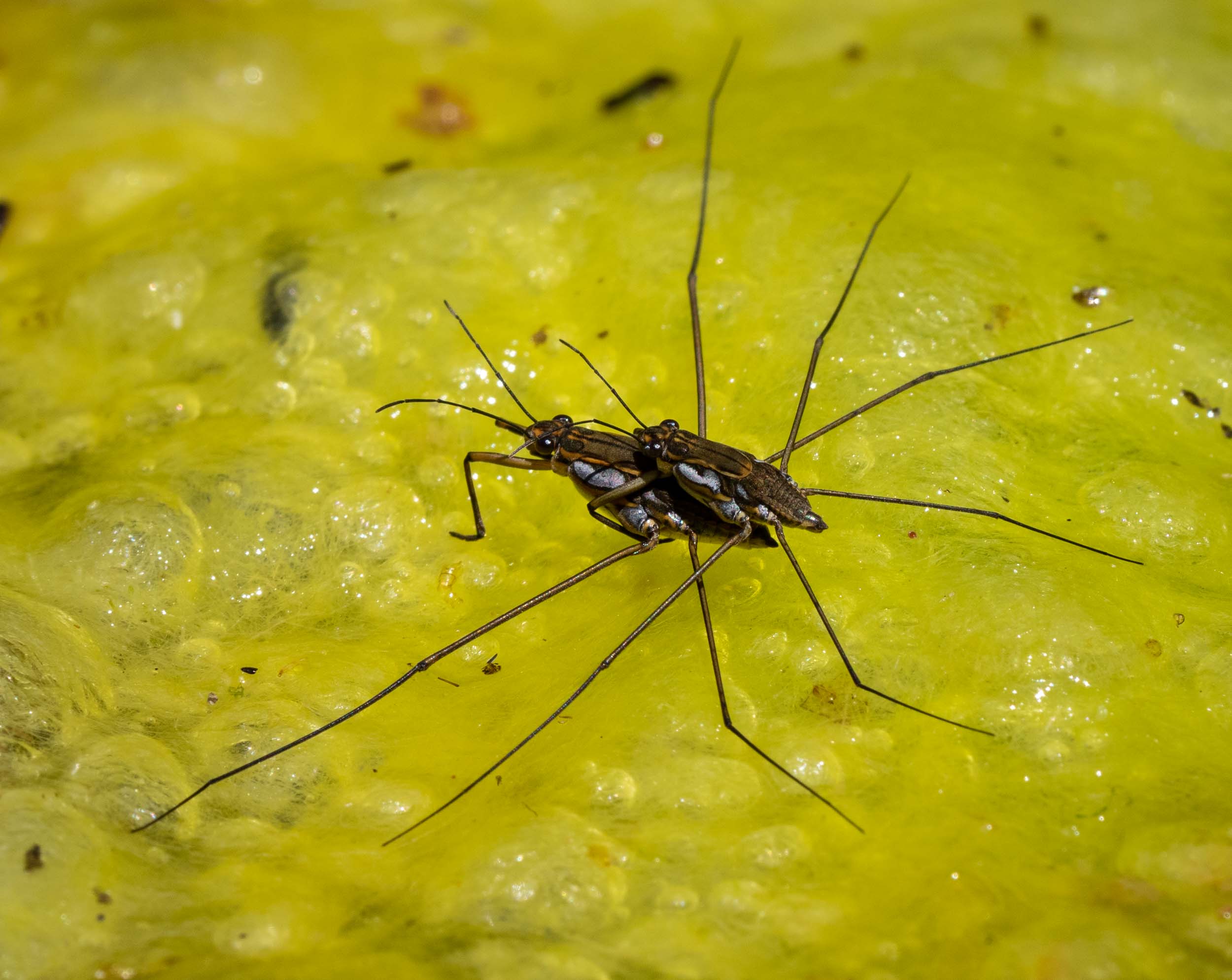Water Striders

After watching masses of water striders skating about a beachside lagoon a few weeks ago, I’ve been seeking to learn a bit more about this rather bizarre group of bugs.
They’re actually quite familiar looking insects. Long legs, sliding about on the water surface, the characteristic footprints … little dimples in the surface tension. But what kind of insects are they, and what are they doing?
Water striders are bugs. That is, they belong to the order Hemiptera. There are several related families, all with the ability to live and feed on the water surface.
The long-legged Gerridae – the ‘true’ water striders – occur worldwide. And they’re a rather well-studied family. Their ability to walk on water, their curious courtship and mating behaviours, and the ease with which they can be kept in captivity make them irresistible insects for research.
Species identity: Tenagogerris euphrosyne
My first step … which species do we have here?
Fortunately, there is an excellent CSIRO paper (Anderson & Weir, 1997) which enabled me to identify them. They belong to the genus Tenagogerris, a group that is endemic to Australia.
The species … Tenagogerris euphrosyne. It is found across eastern Australia, from north Queensland to Victoria. Tenagogerris euphrosyne varies in colour across its range, with adults of southern populations being considerably darker than those from the far north.
Tenagogerris euphrosyne (winged form)
In our region, there are a couple of other water strider species we might expect to find. Aquarius antigone is reported for eastern NSW, although not usually this near the coast. And a confirmed sighting of Limnogonus just to our north last year (see Atlas of Life record) is the first reported sighting of the genus south of Sydney. The novelty of the sighting could be due to the southward spread of species, or it could be that the south coast has historically been under-surveyed.
Extended coupling
It is common to see water strider couples. The smaller males cling to the backs of the females, even when not actually mating.
Tenagogerris euphrosyne pair - the smaller insect is the male
This behaviour, and the signals that precede it, have been extensively studied. In some species of water strider the female must first indicate her willingness before the male will mount. In other species – including T. euphrosyne – the males don’t signal, they simply jump on. Or attempt to. The female either skates away or acquiesces, with just a brief struggle.
Interestingly, males cannot feed while riding. The females can, and do. But it’s not all bad news for such males. Researchers have shown that males with the longest front legs are the most successful at mating, and the most successful at foraging. They don’t starve.
Water striders breed year round in northern Australia, but here in the south adults are scarce between May and October. As our own observations show, December is certainly a month of high breeding activity!
photo taken December 2018, on a nearby beachside lagoon
Voracious predators
These delicate-looking insects are very effective hunters and scavengers. Any insect or spider, small or large, that becomes trapped on the water surface is fair game. The water striders sense the vibrations of the struggling animal, and quickly skate over to investigate.
There was strong competition for this Xmas lunch at a nearby beachside lagoon (photo taken 25/12/18)
The bug pierces its prey with a strong proboscis, injects digestive juices, and then sucks out a meal … the standard feeding strategy among bugs.
Wings or no wings
Most adult T. euphrosyne are wingless. For example, none of the dozens of couples we sighted at the beach lagoon had wings.
A wingless T. euphrosyne male, resting briefly on an algal mat
Depending upon environmental conditions, however, some nymphs will develop into winged adults. They are quite different in shape - particularly across the pronotum (the ‘back’). And these winged individuals do fly, providing the means for the species to disperse and colonise new environments.
A single, winged T. euphrosyne suddenly appeared on our home frog pond last week. This is the first time we can recall ever seeing a water strider here.
Based on the body size and wing length (just reaching the end of the abdomen), I think this might be a female. If it is, she could already be laying eggs in the pond vegetation. Lone, previously mated females are able to lay eggs for weeks, although their fertility rate does decline with time (see Colvin, et al).
Perhaps the ecosystem of our little pond has just gained a whole new insect component.
References:
Anderson, N.M. & Weir, T.A. (1997) The gerrine water striders of Australia (Hemiptera: Gerridae): Taxonomy, distribution and ecology. Invertebrate Taxonomy, 11, 203-299 (available here, via ResearchGate)
Colvin, P.G.R., Elgar, M.A. & Jones, T.M. (2006) Life-history traits and the mating system of an Australian water strider, Tenagogerris euphrosyne. Australian Journal of Zoology, 54, 107-116. (available online)
A link to my own informal notes, made while identifying this species: Water Striders (Gerridae: Gerrinae)










